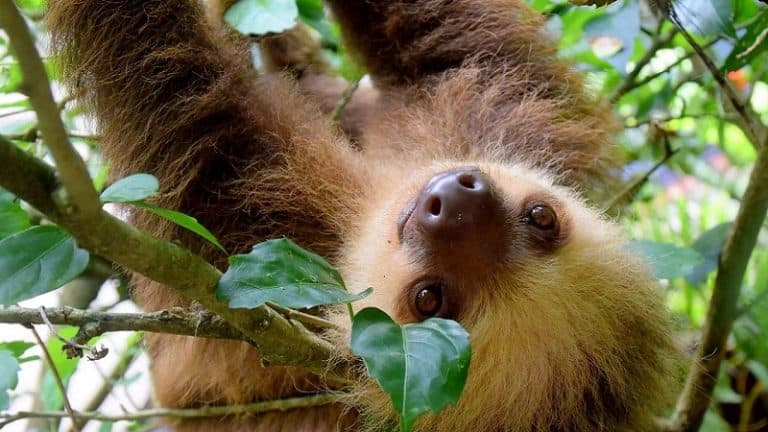Drones can accomplish a lot of extraordinary things in the world today. Among them though, the preservation of endangered species and at-risk environments is one of the most important. Already, drones are monitoring wildlife in ways that provide invaluable insights as we seek to preserve the natural world.
They are being deployed to count animals and take photos and footage of ecosystems in a way that’s far more efficient than other methods. And with the information drones collect through these efforts, related organizations can be better informed as they make decisions regarding conservation and protection.
This is a fascinating idea, and one that’s already been in action for a couple of years now. However, it’s also now being improved upon by a bizarre, loosely related, and frankly, somewhat goofy concept: robots based on sloths. Designed to mimic the slow, gradual movement of sloths through the trees, these drone alternatives have recently emerged as options that may be more effective than drones, at least in certain situations.
If this sounds like a bizarre concept, consider first a few of the potential issues that can arise with drones in wild, natural environments:
Inconvenient Builds
Drones at this point have become fairly adaptable. There are devices of different sizes and capabilities, and even foldable drones that can change size to some extent. However, there aren’t yet perfect solutions for the purpose of environmental surveying.
Prolonged exposure in natural habitats can require more power than one typically finds in a smaller drone, whereas a larger drone might be disruptive enough as to corrupt data (say, by causing wildlife to scatter, thus resulting in inaccurate counts). This is not to say that there aren’t drones that will work for certain tasks or in certain situations. But finding the right mix of size, performance, and the ability to blend in can be difficult.
Inadequate Circuit Protection
As impressive as their performance can be, drones can also be vulnerable to a number of different technical failures — particularly when they’re depended upon for long outings in challenging conditions. It’s for this reason that it’s generally accepted that robust electrical protection is essential if drones are to operate as needed.
This means strong casings for batteries, designs that conceal circuits and cables, antennae that are protected or hidden from view, and so on. Any small vulnerability in any one of these areas can lead to damage, resulting in a drone that either needs repair or — worse — crashes in a natural habitat.
Heavy Power Demands
Drones are ultimately run, like so many other electronic devices, on internal circuit boards, which are designed to handle the needs of individual machines. Modern power delivery system design for electrical circuits is specifically meant to handle the increasingly robust demands of modern devices. Larger circuits, for example, sometimes made with millions of transistors to meet computer-like demands even on smaller devices, can be built with different operating voltages as a means of keeping the power demands from overpowering the circuits.
Where drones are concerned though, it’s not always clear if devices’ internal circuits are built to withstand particularly difficult conditions — such as a longer-than-expected excursion, or use in extreme heat. It’s possible for power demands to exceed capability.
The challenges just outlined are not meant to covey that adequate drones can’t be built. There are drones that can be used effectively for wildlife and environmental surveys, and as mentioned, some of them are already being deployed. However, solving the challenges above can be expensive and difficult. The alternative machine — the “sloth bot” — is simply meant to provide a more sensible alternative.
Meet the SlothBot
Described as a “very cute way to boost conservation” and literally called SlothBot, this new innovation is built to be a “slow-moving and energy-efficient” machine that almost literally resembles a playful primate. It’s powered by solar energy, and rather than having to fly on its own, it slides along a thin cable that can be rigged up in environments being studied.
SlothBot moves slowly, such that it doesn’t disrupt its surroundings, and can linger in place for extended periods of time without losing power — thus demonstrating the patience needed to gather thorough data. The machine, in fact, “embraces slowness as a design principle,” according to analysis.
As you can tell even from that description, a device like this solves some of the potential challenges posed by drones. Its size and build matter less, because it’s designed to blend in and operate slowly. Protection of electrical components is less of an issue simply because it will move around less and encounter fewer obstacles. And the slow-moving, solar-powered nature of SlothBot makes power delivery less of an issue too, given that the machine simply has fewer demands on its internal system.
It may not be able to do everything a drone can do, but it’s certainly an interesting, efficient alternative that could become consequential in the fight to preserve the environment.
- Should We Be Calling For “Game Over” On Video Game Remakes? - December 14, 2021
- The Best Video Games Websites of 2021 - December 8, 2021
- 7 Tech Gift Ideas For This Christmas - November 27, 2021

